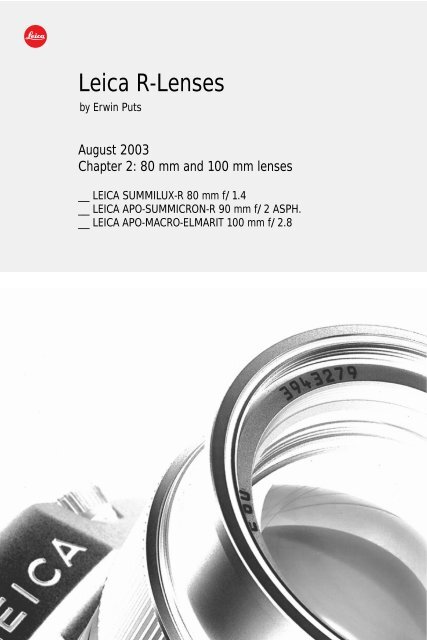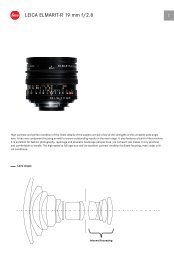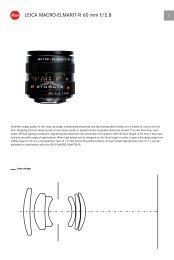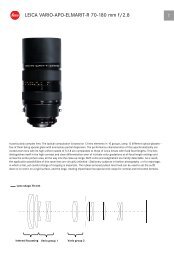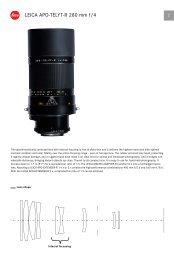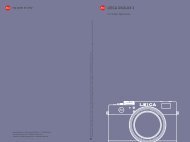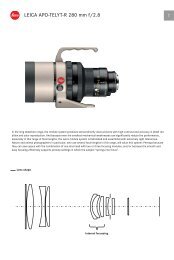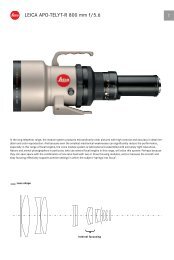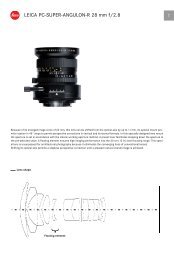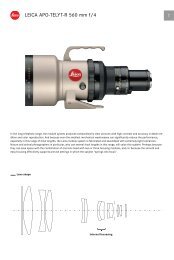You also want an ePaper? Increase the reach of your titles
YUMPU automatically turns print PDFs into web optimized ePapers that Google loves.
Chapter 2 <strong>Leica</strong> R-Lenses 1In older textbooks about photographic techniques there ismuch space devoted to the choice of a lens. At first oneshould buy a 50mm lens and use it for an extended period oftime. Having learned the language of photography, one is prepared,and only then, to buy a second lens. The 90mm lens, oras it was called when focal lengths were measured in centimeters,the 9cm lens, was the next step. Having bought this lensand after studying the laws of perspective, one was ready for awide angle lens. And finally a 135mm telelens could be considered.The first <strong>Leica</strong>flex was introduced was only four focallengths (35-50-90-135) and this was done on purpose. Much ofwhat was known in the past, is still valid today. Lenses are likepersons. Only after a long period of companionship, the truecharacter can be seen and appreciated. A 90mm lens is a moreversatile tool than can be gleaned from the usual catalog description(useful for landscapes, architecture, snapshots,animals). The 'ninety' is a lens that enables you to really investigatethe <strong>Leica</strong> style of photography. If you look at many pictures,you will discover that often the image works overloaded asso many parts of the image ask for attention. A ninety millimeterlens forces the photographer to a selective choice of subjectmatter and thus to exploit the space provided by the quitesmall negative format to its best. Selective enlargement shouldbe avoided as much as possible, as any additional magnificationwill degrade the optimum image quality. In this sense the90mm is an excellent teacher__Artistic reflectionsThe natural perspective is one where the viewing angle in naturalspace is identical to the angle of view when looking at thepicture. The eye has a viewing angle that is close that of a fisheyelens, but in practice the field of vision is much narrower.Fundamental requirement for the correct perspective demandsthat the eye should be positioned at the same location as theentrance pupil of the lens. There is a simple equation that tellsyou that the viewing distance (e) for the correct perspectiveshould be the focal length of the lens (f) times the negativeenlargement (v). As a formula: e = f times v. If you make a picturewith a 50mm lens and wish to look at the negative directly,your eye should also be 50mm from the negative. But the minimumdistance of distinct vision is 250mm and so the negativemust be enlarged 5 times. We need a 5x magnifying glass tosee the picture with the correct perspective. Or you shouldenlarge the negative 5 times to a print to a size of 13x18cm.The well known picture format of 10x15cm requires a 4 x enlargementand is too small. It implies that you will look at the picturewith an extended space perception. You look at the picturewith a wide angle perspective so to speak. When a format of13x18cm is used and the picture is made with a 50mm lens,then this 5 times enlargement will provide for a correct andnatural perspective. The picture format of 13x18cm has a diagonalwith a length of 222mm and that is quite close to theminimum distance of distinct vision of 250mm. The angle ofview is now about 50 degrees and this corresponds to theangle of view of a 50mm lens (45 - 47 degrees). But this minimumdistance is very often quite uncomfortable in many situations.You may not be able to view the whole picture at oncewithout moving your eyes and the distance of 250mm is quiteshort, if you are above 20 years old. Many studies have foundthat he most comfortable viewing distance is twice the value ofthe minimum distance. If you want to keep the natural perspective,you need a lens with a focal length that is twice the valueof the diagonal of the negative format, thus 2 x 43mm. A focallength of 86mm, then would be the ideal lens. This somewhatsurprising conclusion can be supported by the following observations.The focal length of 90mm is often described as thebest for portraiture. This is true, but why? Let us make a headand shoulder portrait at a distance of 2 meter with a 100mmlens, and enlarge this negative to a print size of 13x18cm. Theformula tells us that we need to look at the picture from adistance of 5 x 100mm, or 50cm. If we now take the same picturewith a 50mm lens at one meter distance, the viewingdistance should be 25cm. But we look at the portrait often at adistance from 50cm as this is more comfortable. Then we lookat the portrait with a wide angle perspective and the impact ofthe image will be different from that taken with the 100mmlens.Perspective is independent from the focal length. If we photographa subject from the same position with a 28mm lens and a300mm lens, the perspective is not changed, only the rate ofmagnification. We can verify this, when we enlarge the 28mmpicture ten times. Let us now compare both pictures and wesee that they are both identical in size and perspective (depthcues). The vertical angle of view of the 28mm lens is 46degrees and that of the 300mm lens is 4.6 degrees. The viewingdistance for the enlargement of the negative with the28mm lens is 28cm (10 times 2,8cm) and for the (not enlarged)picture with the 300mm lens it is 30cm (1 times 30cm).If we take pictures with lenses of different focal lengths at differentdistances to keep the size of the main subject at equalsize, the perspective will change of course. The perspective formulatells that the perspective impression is only then a naturalone, if the viewing angle of the camera in space is the same asthe viewing angle of the eye at the picture. You can ensure thiswhen you carefully adjust these three important aspects: enlargementfactor, viewing distance and focal length. This is truealso when you project slides. The choice of the focal lengthshould always take into consideration the expected enlargementfactor and the normal viewing distance. It cannot be acoincidence that the 90mm lens was very popular with experiencedphotographers. And <strong>Leica</strong> has always offered a wideselection of 90mm lenses, carefully tuned to different tasks. Itmight be a fine exercise to use the 90mm exclusively for onemonth and enlarge all pictures to a size of 13x18cm. The viewingdistance should be about 50cm. Then you really get usedto the correct perspective. A portrait taking with a 90mm has a'flatter' perspective that is 'flattering' for the sitter.
Chapter 2 <strong>Leica</strong> R-Lenses 3The Summicron-R 1:2/90mm displays the typical veil of softflare over the whole image at full aperture, that is the characteristicof almost every high speed lens of the older generation.The typical use of the 90mm as a portrait lens could serve asan explanation and defense of this behavior. The soft reproductionof image details and subject outlines created a morefriendly image of most faces of the sitters. But one did the90mm lens an injustice as it restricted its potential universaluse.The current Apo-Summicron-R 1:2/90mm ASPH (2002) raisedthe level of optical quality substantially. The size is very compactand almost equal to that of the current Summilux-R1:1.4/50mm. Based on size it can be classified as a standardlens. The optical quality is superb and a revelation. The asphericalsurface is grinded by CNC-equipment in a lengthy and elaborateway. Grinding and finishing takes many hours per elementand is so time consuming because of the manyinspections and checks during the manufacture. If a lens ismanufactured with such accuracy, you need a very carefulassembly. The <strong>Leica</strong>-typical construction with metal parts ofexact dimensionality is a necessary condition for a high qualityproduct. This aspherical surface with a large diameter and complexshape has to be assembled with utmost care to ensurethat the theoretical capabilities can be practically available.The optical construction shows a five single elements, and thefirst surface of the third lens has the aspherical shape. Truemastery can be seen in this elegant design. Some time ago oneneeded seven or eight lens elements and could not get this highperformance. The low number of elements, the choice of glassesfor transparency and color transmission, the effective typeof coating, all work together to provide the remarkably clearand crisp rendition. The image quality is very, even at full apertureand veiling glare and secondary reflections are absent. Ifyou take pictures with the sun, directly shining into the frontlens, some aperture reflections can not be avoided.This layout may be indicative for new designs from Solms. Theclassical design with seven or eight elements may be in its finalstage. The current demands have become too high, especiallyin relation to the new method of digital capture.__Three lenses of medium focal lengthThese three lenses do not only differ in their effect on perspectivebut also in their performance at full aperture. Everyone ofthese lenses could be described as a general purpose lens, withexception of the special macro facilities of the Apo-Macro-Elmarit. The angles of view are close together with 30, 27 and25 degrees. In reality the differences are bigger. If we take apicture of a person and a face in vertical format, the subjectdistances are as seen in the table below.Person 1.76 MeterFace 50 cmSummilux-R 80 mm f/1.46.57 Meter1.86 MeterApo-Summicron-R 90 mm f/2 ASPH.7.33 Meter2.08 MeterApo-Macro-Elmarit-R 100 mm f/2.8 7.93 Meter 2.25 Meter
Chapter 2 <strong>Leica</strong> R-Lenses 4At these distances the image size of the person is always the same, but the background is clearly different and has its pictorialeffect on the subject. For formatfilling figure photography, the 100mm is a bit uncomfortable as the distance to the person is quitelarge and here the 80 or 90 are better suited. The most important selection criterion is the performance wide open. In the nexttable I have compared the three lenses in this respect.Aperture 1,4 Aperture 2,0 Aperture 2,8Summilux-R 80 mm f/1.4Medium contrast, some flare.In the center good resolution,in the outer zones mediumresolution, some astigmatismis visible.Medium contrast, low flare.In the center very good resolution,in the outer zones goodresolution, some astigmatismis visible.High contrast.In the center very good resolution,in the outer zones goodresolution with some softness,astigmatism is very faint.Apo-Summicron-R 90 mm f/2ASPH.High contrast, very high edgesharpness, high resolutionfrom center to edge.Very high contrast, very highedge sharpness, very highresolution from center to edge.Apo-Macro-Elmarit-R 100 mmf/2.8Very high contrast, high edgesharpness, very high resolutionfrom center to edge.This evaluation is based on very severe conditions. The testslideswere enlarged to a size 0f 2.40 meter, that is a magnificationof 66 times. Under these conditions, even the minutesterror can be seen, especially as the observer is close to thescreen, where he should not be to be honest! The Summilux-Rshows some characteristics, that are not visible at all at smallermagnifications. From aperture 2.8 all three may be consideredequal in image quality. The performance of the Summilux is inabsolute terms excellent and should be related to the very highspeed. It is not always the case that a very high speed lens canbe compared favorably to a dedicated macro lens of stunningperformance.The MTF graphs are very informative for theappreciation of optical performance. These graphs show themaximum resolution of 40 Lp/mm. That is more than neededfor most picture assignments. The new Digital Back for theR8/9 has a theoretical resolution of 75 Lp/mm. It is interestingto know if these lenses meet the requirements.The Summilux-R reaches at full aperture a value of 100 Lp/mmin the center of the image and 40 to 50 Lp/mm in the outerzones. The edge is weak with 16-25 Lp/mm. At aperture 2these values may be raised by +10 Lp/mm and at 2.8 we havea center resolution of above 100 Lp/mm and in the outerzones above 70 Lp/mm. The Apo-Summicron-R ASPH at fullaperure has a value of above 100 Lp/mm over the full imagearea, excepting the corners where we still have a stunning 50Lp/mm. On the optical axis we even see more than 150Lp/mm. From 2.8 we have a uniform resolution of more than100 Lp/mm with the edge now at 80 Lp/mm. The Apo-Macro-Elmarit-R has the same values as the 90mm lens at aperture2.8.Overall we may declare that all three lenses can exploit the highresolution of the future digital back and they even have somereserve capacity.
Chapter 2 <strong>Leica</strong> R-Lenses 5__ LEICA SUMMILUX-R 80 mm f/1.4With 700 grams the Summilux-R has somewhat less weightthan the Apo-Macro-Elmarit-R. The discussion whether massdoes support the stability of the lens will presumably never end.But a high mass also asks energy from the photographer to supportthe weight and this may counteract the stabilizing effect ofmass. You need to hold the lens immobile for a longer period.The Summilux-R has been classified as a ultra-high speedreportage lens. The brightness of the focusing screen is veryhigh, indeed and the focusing is fast and accurate. The speed offocusing can be improved when you pre-focus at the anticipateddistance and move the camera slightly to and from the subjectfor fine tuning,without larger focusing movements. The truefocus snaps into position on the bright screen.5 [%] Relative Distortion43210-1-2-3-4-50 5 10 15 20Y'[mm]Distortion is surprisingly low with only 0.2% and is even suitablefor architectural photography.100 [%]805.62.81.46040200Vignetting0 5 10 15 20Y'[mm]Vignetting is relativley high with 2.5 stops as a measured value.In practical use, these values should be treated with somecaution. Even landscape pictures with clear sky show only aslight darkening in the corners.
Chapter 2 <strong>Leica</strong> R-Lenses 6100 [%] Aperture Stop 1.48060402000 5 10 15 20Y'[mm]100 [%] Aperture Stop 2.88060402000 5 10 15 20Y'[mm]At aperture 1.4 the overall contrast is medium, as can be seenfrom the graph, where the low frequencies are below 95%. Theimportant 20 Lp/mm are clearly defined with 60% in the centerand 40% in the outer zones. The edge sharpness is a bit soft ascan be seen from the low position of the line for the 40Lp/mm.High contrast scenes with many light sources and deep shadowareas are reproduced with a slight veil of softness, but quitelow halo around bright spots. You will use the wide aperture of1.4 to capture scenes in low light situations that are interesting,moving or informative-documentary in character. For thiskind of photography, the Summilux is eminently suited. The performancewide open is better than can be captured on modernhigh speed emulsions . Stopped down to 1:2 the overall contrastimproves visibly, as internal reflections are effectivelyreduced.Aperture 2.8 again improves contrast and now performance inthe center is very high. In the outer zones the quality lags a bitbehind, but for this type of photography that is not so important.Here you should look at the 20 Lp/mm as the guiding line.
Chapter 2 <strong>Leica</strong> R-Lenses 7[%]100Aperture Stop 5.68060402000 5 10 15 20Y'[mm]Aperture 5.6 can be regarded as the optimum. The edges stay abit soft in the definition, but you need a high magnification todiscern this. In the center of the image where the main subjector action is being located, very fine textures are reproducedwith crispness.The MTF graphs should be studied with some caution. You canoverrate the values that are displayed. I have made comparisonpictures with all three lenses at all apertures on ISO100 slidefilm. The distinctive differences as described above, can beseen only when the magnification is 20 times or more. Youshould also take care of your photographic technique. Wrongfocusing distance and a slight movement of the camera createmore loss in the picture quality than the inherent optical characteristics.The unsharpness gradient is quite pleasing andadds to the impression of depth and space. Specular highlightsare reproduced with finely nuanced hues and that again improvesthe plasticity of the image.
Chapter 2 <strong>Leica</strong> R-Lenses 8__ LEICA APO-SUMMICRON-R 90 mm f/2 ASPH.Since Photokina 2002 the R-photographer can deploy an opticalcrown juwel. Every lens line from every manufacture is built upfrom lenses with differing characteristics, performance levelsand deployment possibilities. There is not one manufacturerwhere all lenses exhibit identically high performance. The ruleis still valid that a lens has to be designed with a large set ofrequirements that are often conflicting an every designer hashis own ideas about what should be the best solution for agiven task. Anyway, sometimes we have a lens that is very difficultto fault and seems to show a very happy synthesis of requirements.The Apo-Summicron-R 1:2/90mm ASPH is such alens. It is really difficult to criticize this lens.At full aperture the performance is already as good as that ofthe Apo-Macro-Elmarit-R 1:2.8/100mm at aperture 2.8. For anaperture of 1:2 this is a most remarkable feat. More importantperhaps is the transparency of the colors and the clarity of thedetails. Extremely fine details are reproduced with very goodcrispness from center to edge. The 40 Lp/mm have an averagecontrast value of 60%, and there is no race of astigmatism ofcoma in the outer zones. The previous version of the Summicron90mm had a contrast of 30% for the same 40 Lp/mm. Adoubling of the contrast of the fine textural details is more thanjust visible: it is a new experience for high speed lenses. Stoppeddown the performance improves only slightly.100 [%] Aperture Stop 2.08060402000 5 10 15 20Y'[mm]
Chapter 2 <strong>Leica</strong> R-Lenses 9100 [%] Aperture Stop 2.88060and the extreme edge rays are blocked. If you look carefully,you may see the result of the diffraction at aperture 5.6: theoverall contrast for the 5Lp/mm is slightly reduced comparedto the values at 2.8.40200[%]10080600 5 10 15 20Y'[mm]Aperture Stop 5.65 [%] Relative Distortion43210-1-2-3-4-50 5 10 15 20Y'[mm]4020Distortion is low with 1% but may be visible on critical inspectionand suitable subjects. The Summilux is better here.00 5 10 15 20Y'[mm]The graphs for 2.8 and 5.6 indicate an improvement for the20Lp/m and the 40Lp/mm, but the jumps are quite small.Compare the jumps in performance of the Summilux. The residualaberrations of the Apo-Summicron are already so low atfull aperture that stopping down only improves the depth offield. At smaller apertures the internal reflections are reduced
Chapter 2 <strong>Leica</strong> R-Lenses 10Vignetting100 [%] 2.0805.62.860402000 5 10 15 20Y'[mm]Vignetting amounts to 2 stops wide open, but can already beneglected at 2.8, and is even lower than that of the Apo-Macro-Elamrit at 2.8. The apochromatic correction is effective fromaperture 1:2 and can be seen from the non existant color fringesat high contrast edges. Still the correction is not perfect. Atvery steep black-white borders (and color-white or color/blackborders) a very small color fringe can be detected, but onlyjust and in high magnification. The unsharpness gradient is notas smooth as can be seen with the Summilux 80mm. Some veilingglare can be detected in strong back light and large areasof sky that work as a light box. At distances below 1.5 meterthe definition of very fine structures softens a bit at the widerapertures. Stopping down to 5.6 will save the day. Using theApo-Extender-R 2x, you get a very fine 4/180mm lens, thatshould be stopped down to smaller apertures at distancesbelow 2.5 meter for best quality.These remarks should not be interpreted as nitpicking. Astester you simply stumble across some limits, how far off theymay be, and these should be noted. The Apo-Summicron-R1:2/90mm ASPH is a superb lens in any sense of objectivity,that beraks all previous limitations. With a weight of 520 gramsand a small size it may be sen as the ideal standard lens.
Chapter 2 <strong>Leica</strong> R-Lenses 11__ LEICA APO-MACRO-ELMARIT-R 100 mm f/2.8There are persons who always seem to operate at maximumefficiency, show a uniform performance, never get angry andnever say never. Such persons you meet only once in a lifetime.You may jealous of such a person. Some lenses have this charactertoo. The Apo-Macro-Elmarit-R 1:2.8/100mm is such alens. In direct comparison to the Apo-Summicron-R 1:2/90mmASPH, the maximum aperture is slower by a stop, the performanceover the entire distance range uniformly high. Theseparameters define the choice. If the near focusing range(1 meter to 20cm) is not important, the Apo-Summicron-R is thebetter choice (better ergonomics, less weight and more speed).
Chapter 2 <strong>Leica</strong> R-Lenses 12100 [%] Aperture Stop 2.88060402000 5 10 15 20Y'[mm]100 [%] Aperture Stop 5.68060402000 5 10 15 20Y'[mm]At aperture 2.8 the performance is uniformly high: high contrastand clarity of details are even better than what you expectfrom medium format systems and this verdict indicates the preferreddomain of the 100mm. On tripod and with carefullyselected emulsions, the R-System reaches distinctive studioquality. The MTF graphs indicate the performance potential.The 5,10 and 20 Lp/mm are at all apertures equally high. At 5.6you note the unavoidable effect of diffraction. Only the bestlenses can 'suffer' from diffraction at this aperture. The 40Lp/mm, responsible for the reproduction of the fine details andthe crispness of the subject outlines, show an interesting shapeof the curve. At apertures of 5.6 and 8 the shape bulges out abit. This is the result of some focus shift. When you stop down alens, the rays at the edges are blocked and the plane of bestfocus shifts a little bit. Often this shift will be compensatedwith a correction state that plays out third and fifth degreespherical aberration. But then contrast drops a bit too at fullaperture.The Apo-Macro-Elmarit-R has hardly any spherical aberrationand already a high contrast at full aperture. Then you will see aslight focus shift more easily. You should also look at thedesign with the two thick single lenses at the rear. The frontgroup (six elements) moves in relation to the rear group (twoelements). Tis is not the same mechanism as with zoomlenses,but a kind of internal focus mechanism. This is also responsiblefor a slight reduction of focal length at the 1:1 macro position:the focal length is here 92mm. You will hardly notice it.The Apo-Macro-Elmarit-R is one of the very few lenses that performsat its best already at full aperture and does not improveon stopping down.[%]100Aperture Stop 8.08060402000 5 10 15 20Y'[mm]
Chapter 2 <strong>Leica</strong> R-Lenses 135 [%] Relative Distortion43210-1-2-3-4-50 5 10 15 20Y'[mm]The distortion is close to zero, and the lens can be used withgood effect for architecture and reproduction.60Vignetting100 [%]808.05.62.8Vignetting is low with a drop of 0.7 stops. My comparison picturesindicate that in practical use the difference in light fall offbetween one and two stops is less important visually than thenumbers seem to indicate. The apochromatic correction hasbeen described in the Summicrons ection and the same applieshere too. Without supplementary equipment the Apo-Macro-Elmarit-R reaches a magnification of 1:2. With the Elpro lens itis possible to get to 1:1. This lens has been calculated specificallyfor the Apo-Macro-Emarit-R. Still one will see a slight dropin contrast at the wider apertures and when maximum magnificationis required you could stop down to the middle and smallerapertures.The Apo-Extender-2 creates a focal length of 200mm and anaperture of 5.6. This is fine for emergency situations, but therelatively small aperture will not give much pleasure.You sometimes can read the statement that the Apo-Macro-Elmarit-R is too sharp for portraiture. I do not share this view.The superb image quality already at 2.8 allows for a clear definitionof the finest modulation of color hues and brightness differenceson film. This aperture has limited depth of field andboth effects work together to create images with high realismand good depth impression. Paul Wolff and Renger-Patch wouldlove to use this lens!402000 5 10 15 20Y'[mm]
Chapter 2 <strong>Leica</strong> R-Lenses 14__To summarizeThese three lenses are on the one hand very similar and on theother hand represent very different worlds, optically and inpracticaluse. The best optical performance we find with theApo-Summicron-R 1:2/90mm ASPH. If the close focusing abilityis not important, this should be the first choice, as the 90mmfocal length gives the most natural perspective and forces oneto concentrate on the photographic language. The performanceat 1:2 boosts the available-light photography with current highspeed films. The photographer who needs or wants to makedocumentary and emotional pictures at very wide aperturesand expects excellent quality in all lighting situations and atsmaller apertures should look at the Summilux-R 1:1.4/80mm.Versatile usability, outstanding performance at all aperturesand distances till 1:1 are the specifics of the Apo-Macro-Elmarit-R1:2.8/100mm. It has not the best ergonomics, but hasexcellent built-quality and is capable of amazingly good pictureswhen using a tripod and medium speed films.


